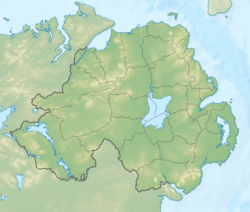Forkhill beer keg bombing facts for kids
Quick facts for kids Forkhill beer keg bombing |
|
|---|---|
| Part of the Troubles | |
| Location | Tullydonnell, near Forkhill, County Armagh, Northern Ireland |
| Date | 17 July 1975 |
| Weapons | Improvised explosive device |
| Deaths | 4 British soldiers |
|
Non-fatal injuries
|
1 |
| Perpetrator | Provisional IRA South Armagh Brigade |
On 17 July 1975, a group called the Provisional Irish Republican Army (IRA) carried out an attack. They used a hidden bomb that looked like a beer keg. This happened when British Army soldiers were checking it. Four soldiers died, and one was badly hurt.
This event was a big deal because it broke a ceasefire. The IRA and the British government had agreed to this ceasefire in February 1975. The attack happened in Forkhill, County Armagh, in Northern Ireland. It was one of many similar attacks by the IRA during the 1970s.
The Attack in Forkhill
On 17 July 1975, a group of British soldiers were investigating something suspicious. Major Peter Willis was with three other soldiers. They were all experts at dealing with bombs. They were checking a milk churn near Cortreasla Bridge in Tullydonnell.
As they walked through a gap in a hedge, a bomb went off. The bomb weighed about 70 pounds. It had been hidden inside a beer keg and buried in the ground. Someone set off the bomb using a wire from about 400 yards away. Four soldiers died right away. Another soldier was hurt by flying pieces of metal.
The soldiers who died were Major Peter Willis (aged 37), Edward Garside (aged 34), Robert McCarter (aged 33), and Calvert Brown (aged 25). They were the first British soldiers to be killed by the IRA since the ceasefire began in February.
What Happened After
The IRA later said they carried out the attack. They stated it was in response to earlier events. Merlyn Rees, who was the British Secretary of State for Northern Ireland, spoke out against the attack. He condemned those who were responsible for the deaths.
An IRA member named Pat Thompson was later found responsible for the attack. He was convicted in March 1976. Thompson had signed a statement saying that a local IRA group planned and did the attack. However, Thompson later said he was forced to sign the statement. He was released from prison in 1991 after serving 15 years.


